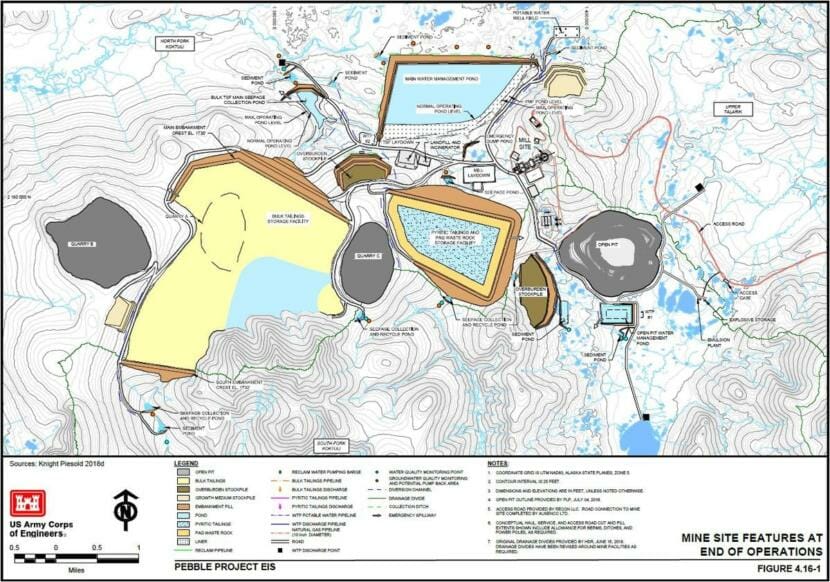
The draft environmental impact statement for the proposed Pebble Mine weighs in at more than 1,400 pages. The public comment period for the draft, which began March 1, is an integral part of determining the final document, which will help federal agencies decide whether or not to permit the mine.
Critics, like the Bristol Bay Regional Seafood Development Association, say that the 90-day window set by the Army Corps of Engineers doesn’t allow enough time for adequate review. The organization, which represents commercial fishermen, is calling for it to be extended to 270 days. Executive Director Andy Wink said that the comment period needs to be longer for a project that he believes could fundamentally change the region’s fishing industry.
“A 90-day comment period is just not enough time to consider the potential ramifications of a mine project like this, especially given what’s at stake with the natural resources and the fish resources in the area. It’s going to take up some time to work through the document,” he said.
A similar sentiment was levied at the state level. In a bipartisan letter to the Corps dated March 1, 20 Alaska state lawmakers, including House Speaker Bryce Edgmon of Dillingham, requested more time for the public to weigh in on what they called “arguably the most important proposed Alaska project of our time.”
U.S. Sens. Lisa Murkowski and Dan Sullivan have also said that they would support extending the time for public input.
Aside from the length of the comment period, the mine’s critics say the document’s shortcomings render it insufficient.
Some have pointed out that the draft EIS does not include a hydrology study to assess the impacts of a major tailings dam failure. To that end, BBRSDA commissioned its own independent study that analyzed several different scenarios if the tailings dam failed. They hired scientist Cameron Wobus from consulting firm Lynker Technologies, who explained those scenarios in a recent presentation.
“The upshot is that in every scenario we looked at, a tailings dam failure would directly impact hundreds of miles of anadromous waters and potentially indirectly impact almost the entire Nushagak-Mulchatna watershed system,” he said.
Dam tailings hold mine waste — the material that remains after extraction. If leaked at the site of the proposed mine, that waste could generate acid and damage water quality and fish habitat in the area.
According to the Corps, the likelihood of such a failure during the mine’s 20-year lifespan would be extremely low — about 1 in 2,000. Wobus argued that since the tailings facilities would be present long after the mine closed, that likelihood would increase over time.
“It’s important to think of this landscape feature as something that will be there for hundreds of years, not 20 years,” he said.
The draft EIS does analyze what would happen if a pipeline running to the bulk storage facility were to rupture. It also assesses the potential of a pyritic tailings breach.
Despite calls to extend the comment period, Pebble Limited Partnership spokesman Mike Heatwole argued that 90 days is a reasonable amount of time to weigh in on the draft, which the company sees as a positive step towards a getting a federal permit for the mine.
“We did a very first pass through the document to make sure we didn’t see any major environmental or data gaps — showstoppers if you will — and certainly didn’t come across any of that,” he said. “And we’ve been spending our time doing a much deeper technical dive and will continue to do that.”
In designing the proposal, Heatwole added, Pebble took the 2014 Mount Polley tailings failure in British Columbia into account.
“We did take a hard look at what happened at Mount Polley and have included a lot of lessons from that in our design, one of which is not using the tailings storage facility as a water storage area and design it as a flow-through. And then reinforced the buttress walls, if you will, to make sure the stability of the structure was sound,” he said.
Pebble’s proposal separates the bulk and pyritic tailings storage facilities. The pyritic tailings hold a higher level of potentially acid-generating materials. By placing those tailings in a separate, synthetically-lined storage pond, Pebble maintains that it will limit the spill risk to the mine’s operational years.
Another issue sparking local concern is that Pebble proposed an ice-breaking ferry that would transport mining materials across Iliamna Lake daily. In the draft EIS, one action alternative to Pebble’s plan is a transportation corridor that would eliminate the ferry entirely.
Heatwole said that the year-round ferry proposal is still their preferred route. But he pointed to the alterations Pebble did make to its proposal, adding that they will continue to take public input into consideration as they move forward.
“The plan that we’ve brought forward took a lot of stakeholder concerns and issues to heart, you know, with the smaller footprint, no use of cyanide, consolidating the footprint into primarily the North Fork Koktuli (River), more safeguards for the tailings facility and things of that nature,” he said.
The public has until May 31 to weigh in on the draft. Nine public hearings will take place in the coming weeks, beginning March 25. Public comments submitted in person, online or by mail will help inform the final EIS, estimated for release in early 2020.
BBRSDA is a supporter of KDLG’s Bristol Bay Fisheries Report.




